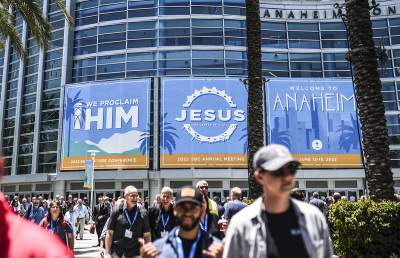
For decades, denominations have experienced a slow-motion deterioration. The declines in any one year are subtle, but each year’s cumulative effects have become a serious problem. Why should we care?
Some look at denominations like the folding divider walls in a large room — unnecessarily compartmentalizing believers into theological camps and keeping them from uniting for the mission of God. There is some truth to this perspective. However, there are far more benefits to denominations than detriments. While denominations can become too insular, they provide an institutional foundation that no single organization or network can.
- Theological consistency and clarity.
- Accountability for both pastors and churches.
- Clergy benefits, such as health insurance and retirement.
- Training, development, ordination, and licensing.
- Financial resources for church revitalization and cross-cultural mission work.
- Support networks and fellowship groups.
In short, both pastors and churches have a trusted contact to call for solutions to a wide range of questions and problems. Are denominations necessary for the Kingdom of God to grow? No. Can they be good for the Kingdom of God? Yes.
Across the theological spectrum — from mainline to Evangelical — denominations are shrinking. In this article, we look closely at the Southern Baptist Convention (SBC), the largest Protestant denomination in the United States, as a case study in what’s happening, why it’s happening, and what comes next.
Denominations reflect their churches
Denominations don’t exist apart from their churches. They reflect the churches within them. When there are more healthy churches than unhealthy churches in a denomination, it’s healthy. It’s unhealthy when there are more unhealthy churches than healthy churches in a denomination. The problem most denominational executives face is that there are typically far more unhealthy churches than healthy ones. They are forced into triage leadership rather than strategic leadership.
When churches thrive, so do the networks that support them. When churches decline, those networks falter. For the SBC, the signs of struggle are everywhere: institutional downsizing, sex abuse scandals, weakening financial support systems, heated theological battles, and a shift away from evangelism as the central mission. But how big is the problem really?
The scale of the decline in the SBC
The first signs of trouble emerged in the early 2000s. I wrote in 2004 about the “striking plateau” of baptisms and the “inefficiencies” of our evangelism compared to previous eras. My father followed with another similar and more detailed report in 2005. These initial warnings were largely ignored, but the data and statistics were there. And the plateau we both saw became a precipitous decline.
According to research by Dr. Ryan Burge, the SBC has lost membership for 18 consecutive years. Membership peaked in the 2000s and has been on a steep slide ever since.
Some have commented, “we’re just cleaning up bloated membership roles,” but that’s not the case. It’s not a decline on paper. People are actually leaving. If “inactive” members are being removed from rolls, then the percentage of people who are “active” (attending weekly) should go up relative to the 2000s. Unfortunately, the opposite has occurred.
- Percent of SBC weekly attenders in 2024: 34%
- Percent of SBC weekly attenders in 2004: 37%
This decline isn’t from cleaning up inactive rolls. These are real people leaving the pews — and not coming back. Even though average weekly attendance has increased slightly since the pandemic low, it’s still over 30% below the peak and hasn’t recovered to 1980s levels.
- SBC weekly worship attendance in 1991: 4.6 million.
- SBC weekly worship attendance peak (2009): 6.2 million.
- SBC weekly worship attendance in 2024: 4.3 million.
Perhaps the most sobering comparison is this: the membership losses the SBC has experienced in recent years are equivalent in size to entire mid-sized denominations. It’s not just a few churches closing; it’s a structural hemorrhage.
Evangelism: A glimmer of hope for the SBC
Baptisms are often seen as a marker of a church’s evangelistic health. In 2024, the SBC reported more baptisms than in 2019, the last full year before the COVID-19 pandemic. While this is a reason for optimism, it doesn’t erase the fact that the denomination still loses more members annually than it baptizes. Baptism numbers have dropped by more than 40% since the late 1990s and are 44% below the peak of the 1970s.
Is this recent growth in the last four years a genuine inflection point or merely a post-pandemic rebound? The answer remains unclear. One could surmise that a portion of the uptick in the previous few years was pent-up demand from pandemic church closures. What is clear is that the evangelistic engine that once fueled denominational growth is no longer firing on all cylinders. We have more churches and more money, but far less evangelistic energy.
Aging and generational disconnect
Another challenge the SBC faces is its age profile. While not the oldest Protestant group, the SBC lags behind in reaching younger generations. Even denominations like the Presbyterian Church in America (PCA), which has an older average membership, report more engagement from young adults.
The SBC has one of the smallest representations of the two youngest age categories (18-35 and 36-44). Now, let’s consider a few facts here.
1. The SBC grew in worship attendance from the 1980s to the early 2000s.
2. At the same time, baptisms were declining rapidly.
3. During this same period, the SBC was beginning to age quickly.
What do we make of these data points? The SBC expanded in the 1980s and 1990s primarily through Baby Boomer transfers from other denominations, not new conversions, and it never truly captured the hearts of the generations that followed, including our own children.
The diagnosis of decline
I’ve been surprised by the recent conclusion of some SBC leaders and commentators. Some of them claim that denominational decline is a kind of spiritual refinement, a purification process filtering out those who are not aligned. But that narrative sounds eerily similar to what mainline denominations said a generation ago as they experienced their own steep declines. When the desire to purify is greater than the desire to reach others, we’ve reached the point where the inward pull is greater than the outward call.
I believe more is happening than a simple purification process. A convergence of factors is creating a downward pull on the SBC.
1. Worship attendance frequency: People fade before they leave entirely. When weekly attenders start coming every other week, your attendance declines by half. Though it’s difficult to know the precise impact of declining attendance frequency in the SBC, I believe it has dramatically affected recent years’ declines.
2. Scandals and theological infighting: What makes the headlines does influence the broader public. Some will claim the recent negative headlines are unfair. Others will say it’s been a long time coming, and the SBC is getting exactly what it deserves. Whatever your position, the benefits of staying no longer outweigh the costs of leaving. So, people are walking away.
3. Large churches and future trends: Some of the largest SBC churches have either been kicked out (e.g., Saddleback) or disaffiliated (e.g., Elevation). While the SBC is a denomination of smaller churches, more people go to the largest churches. When the largest churches leave the SBC, their statistics go with them. These churches account for a substantial portion of overall worship attendance and baptism figures.
In truth, declining worship attendance frequency, a string of sex abuse scandals, theological infighting, and the exit of prominent megachurches have converged and created an atmosphere not conducive to growth. So, what’s next?
The continued slow deflation of the SBC
The SBC isn’t going anywhere anytime soon. And that’s the problem. Consider where you put your energy. You can work hard with good intentions on the wrong things. You can exhaust yourself in misdirected endeavors. The SBC expends a lot of energy (and financial resources) every year. Much of this work is done with good intentions by hard-working people. Perhaps the latest uptick in baptisms indicates that some of this work is beginning to pay off. I certainly hope so. The next three or four years will be revealing as to whether we’re seeing a true return to the focus of evangelism.
What the statistics demonstrate right now is that the SBC is still in a multi-decade decline. The metaphor is apt: the SBC is not imploding — it’s deflating, like a balloon slowly losing air. I don’t expect an explosion. Just a slow fade as the air continues to leak.
The future may belong to regional bodies that can reassert denominational identity with strategic focus and missionary passion. Watch as state conventions in the SBC become more like mid-size and small denominations. If nothing changes, I expect more Cooperative Program funds will remain in the states and less will go to national entities. The funding pie is shrinking, and the fight over proportional pieces will only intensify. Meanwhile, non-denominational churches will continue to rise, and many existing SBC churches will quietly de-emphasize their denominational ties.
The story of denominational decline is not just about numbers — it’s about mission drift, generational gaps, and misaligned priorities. If the SBC and other denominations are to experience renewal, it won’t come through institutional preservation but through a grassroots return to evangelism and discipleship. The question is not whether denominations will survive, but whether they will still matter. And that depends entirely on whether they can reclaim their purpose and passion for reaching people with the Gospel.
The decline of denominations is reshaping American Christianity. Whether that reshaping leads to renewal or continued erosion depends on how local churches respond.
Originally published at Church Answers.
Sam Rainer is president of Church Answers and pastor at West Bradenton Baptist Church in Florida.


















